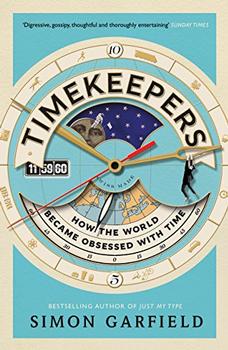Summary | Excerpt | Reviews | Beyond the Book | Readalikes | Genres & Themes | Author Bio

Critics' Opinion:
Readers' Opinion:
First Published:
Jan 2018, 368 pages
Paperback:
Dec 2018, 368 pages
 Book Reviewed by:
Book Reviewed by:
Rory L. Aronsky
Buy This Book
But it was on the vast continent of North America that the issue of a standard time faced its greatest challenge. Even in the early 1870s, an American rail traveller would have to be confident indeed, for the station clocks offered 49 different times from east to west. It was noon in Chicago, but 12.31 in Pittsburgh. The issue assumed particular urgency after 1853, when irregular timekeeping caused several railway fatalities (it didn't help that trains usually travelled in both directions on a single track).
A set of timekeeping instructions issued in August 1853 by W Raymond Lee, the superintendent on the Boston and Providence Railroad, laid bare the complexities, and the propensity for human error. In part, it read like a Marx Brothers script: 'Standard Time is two minutes later than Bond & Sons' clock, No 17 Congress Street, Boston' the first of these began. 'The Ticket Clerk, Boston Station, and the Ticket Clerk, Providence Station, are charged with the duty of regulating Station Time. The former will daily compare it with Standard Time, and the latter will daily compare it with Conductor's Time; and the agreement of any two Conductors upon a variation in Station Time shall justify him in changing it.'
And so the call went out to on an unlikely group of specialists. American astronomers had long argued that their observatory time was the most accurate available, and they were now required to set station clocks wherever possible (taking over from town clocks and jeweler's windows as the custodians of reliability). Around 20 astronomical institutions administered time to the railways in the 1880s, with the US Naval Observatory taking the lead.
Apart from the astronomers, one figure stands out. A railway engineer named William F Allen was permanent secretary of the General Time Convention, and had long seen the advantages of a universal time system. At a meeting in the spring of 1883 he had laid out two maps before the assembled officials that seemed to establish his case beyond doubt. One was a forest of colours showing almost fifty lines, as if scribbled by an angry child, and the other was a smooth display of four broad colour-bars, running north to south, each fifteen degrees of longitude apart. Allen claimed that the new map carried all 'the enlightenment we hope for in the future'. Allen was proposing a remarkable thing: that his continent's timekeeping be based not on its national meridian, but on a meridian beyond its borders, and upon signals received by electric telegraph from the Royal Observatory at Greenwich.
In the summer of 1883, Allen sent maps and details of his proposals to 570 railway company managers, and gained approval from the vast majority; he then supplied them with 'translation tables', to convert local time to standard. And so the familiar era of public timekeeping began at noon on Sunday 18 November 1883, and the 49 previous time zones were reduced to four. Observing the transition from the Western Union Building in New York City, Allen noted, 'the bells of St Paul's strike on the old time. Four minutes later, obedient to the electrical signal from The Naval Observatory … local time was abandoned, probably forever.'
As in Europe, the railways' strictures gradually spread to the locale in which they operated, and adhesion to the timetable on the tracks dispersed to all aspects of daily life. But, as in Europe, not every city delighted in the imposition of uniformity. Pittsburgh banned standard time until 1887, while Augusta and Savannah resisted until 1888. In Ohio, members of the Bellaire school board voted to adopt standard time and were promptly arrested on the orders of the city council. Detroit protested louder than most: although strictly part of the Central time zone, the city maintained local time (28 minutes behind Standard Time) until 1900. Henry Ford, who trained as a watch repairer before he revolutionised the car business, made and sold a watch that told both standard and local time simultaneously, and both remained in use until 1918.
Excerpted from Timekeepers by Simon Garfield. Copyright © 2017 by Simon Garfield. Excerpted by permission of Canongate Books. All rights reserved. No part of this excerpt may be reproduced or reprinted without permission in writing from the publisher.





The House on Biscayne Bay
by Chanel Cleeton
As death stalks a gothic mansion in Miami, the lives of two women intertwine as the past and present collide.

The Flower Sisters
by Michelle Collins Anderson
From the new Fannie Flagg of the Ozarks, a richly-woven story of family, forgiveness, and reinvention.

The Funeral Cryer by Wenyan Lu
Debut novelist Wenyan Lu brings us this witty yet profound story about one woman's midlife reawakening in contemporary rural China.
Your guide toexceptional books
BookBrowse seeks out and recommends the best in contemporary fiction and nonfiction—books that not only engage and entertain but also deepen our understanding of ourselves and the world around us.